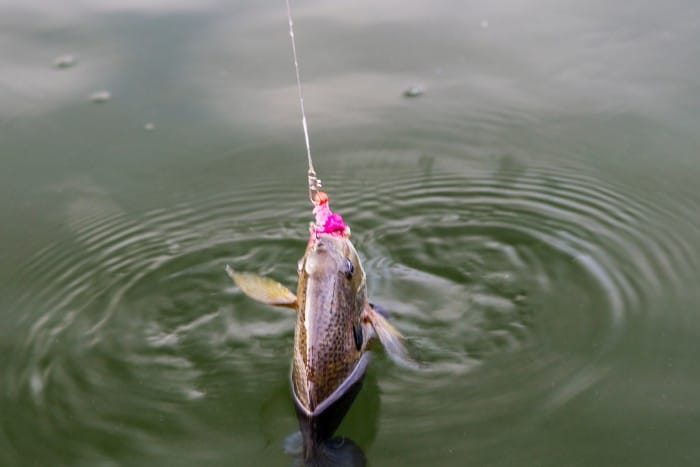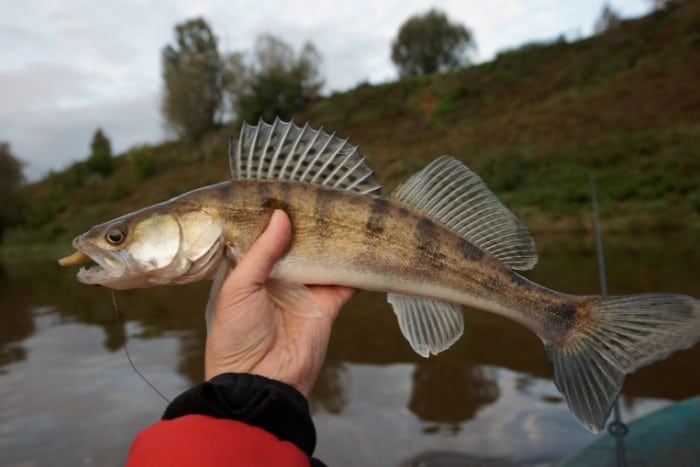While it’s no secret that jigging is one of the most effective ways to ice fish, there isn’t a one-size-fits-all jig that will land you every type of fish in every situation. The jig size you should use heavily depends on the kind of fish you’re targeting and their activity level.
If you’re ice fishing for panfish, somewhere between a 3-5mm (1/64 oz to 1/16 oz) jig is ideal. If you’re ice fishing for walleye, pike, or a similar fish, a 5-7mm (1/16 oz to 1/4 oz) jig is best because you’re required to get lower and deeper in the water column where they would like to sit.
Understanding the desired jig sizes for fish will significantly impact your success on the water.
Recommended Jig Sizes For Different Fishes While Ice Fishing
1. Jig Size for Panfish
Panfish are considered to be most species of crappie, perch, and sunfish. When you’re targeting them, you can assume that they’ll likely be in 10-20 feet of water near structure and aquatic plants.
During the winter, these fish aren’t overly active, and they usually stay in schools. You don’t need a massive jig in 10-20 feet of water.
A 1/32 oz and a 1/16 oz is plenty to get to that depth. Most bodies of water that hold panfish don’t have strong currents pulling your jigs away from those target areas.
A 1/16-ounce jig will fall quickly enough in the water column to capture the fish’s attention. If the fish aren’t biting with the 1/16-ounce jig, it’s not a bad idea to move to a 1/32-ounce jig.
Plus, you’ll be able to feel any sort of strike or nibble that you may get on the jig.
When in doubt, it’s best to go smaller and see if the fish aren’t wanting to be as aggressive and are hoping to eat something with a bit less size.
A 1/64-ounce or even a 1/128-ounce jig may be what the fish want. If the panfish are sitting in water that’s 5 to 10 feet deep, you’re likely going to choose a jig that’s even smaller than 1/32 ounce.
In the winter, fish are rarely this shallow, but it can happen if there’s been an especially warm streak and the water temperatures begin to regulate themselves.
Have some of those extra small-sized jigs on hand, but most of the time, your best bet is something between a 1/32 ounce and a 1/64 ounce.
You won’t be fishing deep enough that you need a massive jig to get you lower in the water column.

2. Jig Size for Walleye
If you’re fishing for walleye and hoping to use a jig, you’ll want a jig between 1/16 ounce and 1/4 ounce. If you know the fish are somewhere 20 feet and above, stick with a 1/16 or 1/8-ounce jig.
These are heavy enough to attach a minnow or worm and still create enough action to attract the fish’s attention.
Walleye are generally bottom feeders, so you’ll want to ensure your jig is heavy enough to reach the bottom and stay there in case the fish are especially stagnant.
Walleye will strike a minnow that’s suspended over the bottom near drop-offs, so it’s essential to make sure you know the proper depth and make sure your jig is heavy enough to reach it.
If you’re fishing water that’s deeper than 20 feet, you have to plan to use a heavier jig. Many anglers use a 1/4-ounce jig tipped with a decent-sized minnow.
Fishing below 20 feet through the ice can be challenging. As a result, you need to make your presence known. Fish that are sitting below 20 feet are searching for warm water.
During the winter, the warmer water is deeper, so walleye may be sitting in areas they may not otherwise sit in during the warm months.
An appetizing 1/4 ounce jig tipped with a minnow will look incredibly delicious to them.
Generally, you won’t have to go heavier than a 1/4 ounce jig, but it may be required, especially if you’re fishing rivers or larger bodies of water with currents.
It’s important to know the conditions of the water you’re fishing in before choosing the jigs you want to use.
3. Jig Size for Trout
If you’re fishing for trout through the ice, you’ll notice that many of them sit in shallower water.
While trout metabolism slows in the winter, they aren’t as susceptible to cold water temperatures as many other types of freshwater fish. A good jig size for trout is somewhere between 1/32 and 1/8 ounce.
If you’ve spent any time ice fishing for trout, you’ll notice that anglers will target them in 5-15 feet of water. They cruise along in smaller schools searching for crustaceans or other smaller minnows.
Trout don’t require a massive jig, so as long as you have an active minnow or wax worm attached to your jig, you have a great shot at landing them.
When trout are sitting in that 5-10 feet of water, start with a 1/16 ounce jig. It’s a bit smaller and gives you a chance to see if the fish will be especially aggressive.
If they’re immediately striking your 1/16 ounce, you can try moving to a 1/8 ounce jig and see if any bigger fish want to bite.
On the days when trout sit in deeper water (15-20 feet), don’t be afraid to start with a 1/8-ounce jig to give yourself a chance to get to the bottom quickly while still letting your minnow be active.
Trout are an exciting fish to target through the ice. Trout fishing through the ice takes some serious trial and error to find out the ideal method.
Trout aren’t as predictable as panfish, so make sure you are well-equipped with various jig sizes and baits to find out exactly what they want.
4. Jig Size for Finicky Fish
Regardless of the fish species you’re choosing to target; you’ll find that all fish get finicky. What may have worked the day before no longer appeals to them and you’re forced to make some changes.
You’ll always want to try a smaller jig first when targeting finicky fish. For example, if you’re going after walleye in 12 feet of water with a 1/8-ounce jig, switch it to a 1/16 ounce and see what happens.
Don’t change anything else in your setup besides the jig size. If that doesn’t work, try a 1/32-ounce jig.
After that, it may be time to change the style of jig or the spot you’re fishing, but don’t assume that the one jig you chose will always work.
Also, be sure to switch up your jigging technique to help assist you in your attempt to find a method that works.

Conclusion
Ice fishing is often a labor of love. Quality ice anglers are patient and willing to try just about everything they can to land fish.
Don’t be married to one size and method when you’re jigging. If your initial setup isn’t working, try different sizes and techniques to find something that works for you.
Generally, a jig between 1/32 ounce and 1/8 ounce will give you a shot at just about any type of fish you’d like to catch through the ice.
However, there are no guarantees, so make sure you hit the ice well-equipped.
